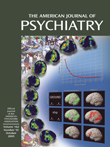Continuities Between Emotional and Disruptive Behavior Disorders in Adolescence and Personality Disorders in Adulthood
Abstract
OBJECTIVE: The purpose of this study was to quasiprospectively investigate continuities between emotional and disruptive behavior disorders in adolescence and personality disorders in adulthood. METHOD: One hundred thirty subjects (age: mean=43.2 years) who had been diagnosed with emotional and disruptive behavior disorders during adolescence (age: mean=14.6 years) and rediagnosed based on hospital records, according to DSM-IV, were interviewed with the Structured Interview for DSM-IV Personality to establish whether they suffered from personality disorders at the 28-year follow-up. RESULTS: Adolescents with disruptive behavior disorders were not more likely to have personality disorders in adulthood than adolescents with emotional disorders. Adolescents with disruptive behavior disorders were significantly more likely to have cluster B personality disorders at follow-up than adolescents with emotional disorders. Logistic regression analyses revealed that disruptive behavior disorders in females were significantly more strongly associated with a high risk of cluster B diagnoses at follow-up than in males. Emotional disorders were significant and independent predictors of cluster C personality disorders in women but not in men. Disruptive behavior disorders were a significant and independent predictor of antisocial personality disorders in men. CONCLUSIONS: These results support the view that personality disorders can be traced back to adolescent emotional and disruptive behavior disorders. The moderating effect of gender in cluster B and cluster C personality disorders suggests that sociocultural and biological factors may contribute to different adult outcomes in men and women with similar adolescent psychiatric disorders.



